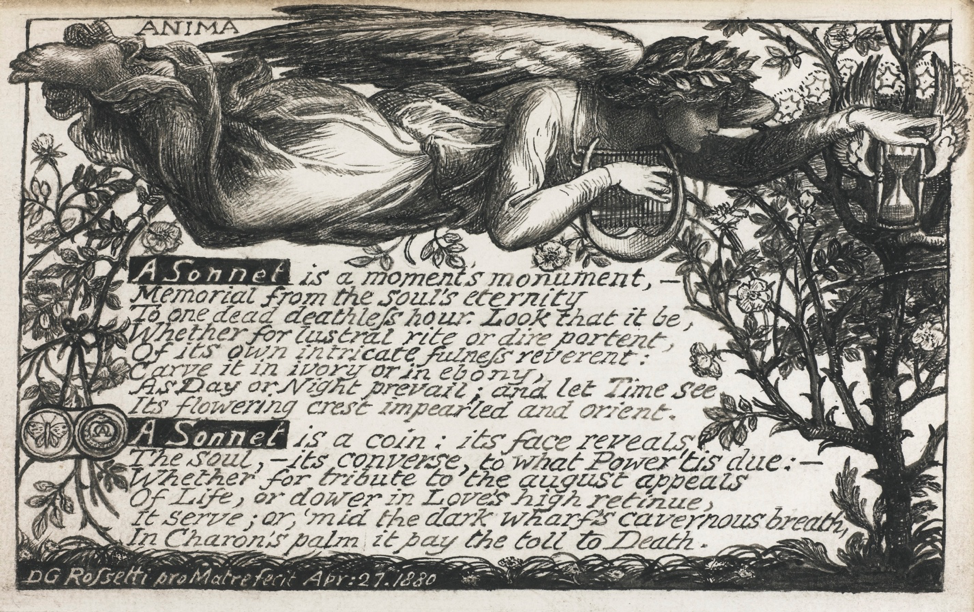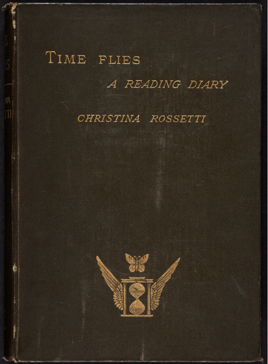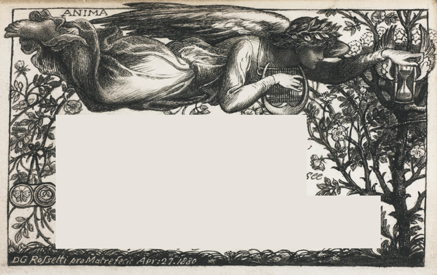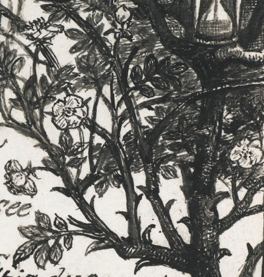Two Rossetti Sonnets Commemorating a Momentous Occasion
Lorraine Janzen Kooistra
|
A Sonnet is a moment's monument,— Memorial from the soul's eternity To one dead deathless hour. Look that it be, Whether for lustral rite or dire portent, Of its own intricate fulness reverent: Carve it in ivory or in ebony, As Day or Night prevail; and let Time see Its flowering crest impearled and orient. A Sonnet is a coin: its face reveals The soul,—its converse, to what Power 'tis due:— Whether for tribute to the august appeals Of Life, or dower in Love's high retinue, It serve; or, 'mid the dark wharf's cavernous breath, In Charon's palm it pay the toll to Death.
Dante Gabriel Rossetti (1880) |
Sonnets are full of love, and this my tome
Christina Georgina Rossetti (1880) |
Figure 1. Sonnets on the Sonnet by DGR and CGR for Frances Rossetti's birthday gift.
In his poetic Introduction to the House of Life sequence in Ballads and Sonnets (1881), Dante Gabriel Rossetti (DGR) celebrates the sonnet as “a moment’s monument”— a gift sent from eternity, commemorating an important moment in time. In her dedicatory sonnet for A Pageant and Other Poems (1881), “Sonnets are full of Love, and this my tome…,” Christina Georgina Rossetti (CGR) celebrates the sonnet as an expression of love that transcends “time and change and mortal life and death” (see fig. 1). While these two Rossetti sonnets are best known in the separate contexts of their published collections of 1881, they made their first appearance in manuscript form a year earlier, inside a book the siblings presented to their mother, Frances Mary Lavinia Polidori Rossetti, on her eightieth birthday. DGR laid his calligraphic sonnet, illuminated with an emblematic design in pen and ink, in the front of David Main’s A Treasury of English Sonnets (1880), while CGR placed her hand-written poem in the back of this book. If sonnets, as DGR claims, have two faces like coins, then his Introductory “sonnet on the sonnet” has both a private face, speaking to the domestic celebration of a family occasion, and a public face, addressing a long history of sonnet writing and his own work within that tradition. In this context, “A Sonnet is a moment’s monument” not only comments on the sonnet’s power to memorialize time as it passes, but also reflects on its ability to capture for posterity, as the illuminated manuscript testifies, a son's love for his mother by offering her his best work.
Prior to their mother’s birthday, CGR sent her brother the specific dimensions required for his illuminated poem. On the verso of a pen-and-ink study with “A Sonnet is a moment’s monument” inscribed in the upper right corner, Christina wrote: “Size of Treasury of English Sonnets” (4 ¾ x 7 in; Rossetti Archive). In the final version inserted into the Treasury, DGR explicitly memorialized the moment of the illuminated sonnet's making by inscribing "DG Rossetti pro Matre fecit Apr: 27: 1880" (DG Rossetti made this for his Mother April 27 1880) in the bottom edge of the composition (fig 2). Although the Latin inscription personalizes the son’s gift, the signature is not the simple and familiar “Gabriel” by which DGR typically signed letters to his mother. The formal signature of the famous artist and published poet “D.G. Rossetti” deliberately situates this work within DGR’s oeuvre. Together, the signature and Latin inscription record the public/private face of the illuminated sonnet, signalling an awareness of its second life as art object in the eternal realm of art, outside the closed covers of a book in a private library marking the eightieth repetition of a single day.

Figure 2. Detail of Illuminated Sonnet by DGR, showing signature. Rossetti Archive.
By inserting DGR’s illuminated sonnet in the front of the Treasury and her own, unilluminated poem in the back of the book, CGR acknowledged the preeminent place of the eldest son, while also privileging the visual/verbal gift over her own unadorned piece. These placements effectively position Christina Rossetti as meta-editor of a grangerized version of Main’s Treasury. A “grangerized” or extra-illustrated version augments an original volume with personally selected drawings, engravings, and the like; the term derives from James Granger (1723-1776), whose Biographical History of England (1769) included blank pages intended for such illustrations. According to the Oxford English Dictionary, this term first came into use in the 1880s when CGR and DGR were preparing the extra-illustrated Treasury, but the siblings had long been grangerizers. One of their first collaborations was in 1854, when DGR’s illustrations were inserted into the printer’s leaves for CGR’s Verses of 1847, bound up together, and presented to their mother (Kooistra 65). Verses had originally been privately printed on the hand press of Frances’s father, Gaetano Polidori. His death in 1853 may have occasioned the extra-illustrated Verses as a memorial gift for the grieving Frances. As meta-editor of the grangerized Main’s Treasury birthday gift, Christina Rossetti demonstrates both familial and editorial judgment. In its laid-in context in the front of the anthology, Dante Gabriel's illuminated "A Sonnet is a moment's monument" functions as a directive frontispiece, while her own "Sonnets are full of love" provides a closing comment on the English sonnets celebrated therein. In effect, the two Rossetti “sonnets on the sonnet” became the “Alpha and Omega" of the national collection, commenting on the long tradition of sonnets as expressions of love, ambition, rivalry, and loss in both private manuscript and public print.
 Figure 3. DGR, Pen and ink drawing for Sonnet (Rossetti Archive)
Figure 3. DGR, Pen and ink drawing for Sonnet (Rossetti Archive)
DGR illuminated his poem with an elaborate ornamental frame whose elements correspond to and comment on the sonnet’s argument about the role of art (fig. 3). Its symbolic design references the early modern emblem tradition of combining poetry with pictures, an interactive hermeneutic system in which he knew his mother to be well versed. In a letter to Frances about the illuminated sonnet, DGR observed:
I have no doubt that your discerning eyes plucked out the heart of the mystery in the little design. In it the Soul is instituting the “memorial to one dead deathless hour,” a ceremony easily effected by placing a winged hour-glass in a rose-bush, at the same time that she touches the fourteen-stringed harp of the Sonnet, hanging round her neck. On the rose-branches trailing over in the opposite corner is seen hanging the Coin, which is the second symbol used for the Sonnet. Its “face” bears the soul, expressed in the butterfly; its “converse” the Serpent of Eternity enclosing the Alpha and Omega. All this I doubt not you had seen for yourself. (Correspondence of Dante Gabriel Rossetti 8.142)
The combination of the winged hour glass representing time’s ephemerality and the butterfly symbolizing the soul’s eternity appears to have been a device meaningful to both Christina and Dante Gabriel. Five years later, this iconography embellished the bindings of CGR’s Time Flies, a reading diary whose entries meditate on time and eternity from the perspective of Christian faith (fig. 4). Like almost all CGR’s books, Time Flies was dedicated to her mother, Frances. In 1885, the repetition of DGR’s device for memorializing “one dead deathless hour” was surely both a poignant reminder to the family that Gabriel had paid “the toll to death” in 1882, and a devout expression of hope for his eternal soul.
 Figure 4. Cover design for CGR's Time Flies (1885). Public Domain.
Figure 4. Cover design for CGR's Time Flies (1885). Public Domain.
In his letter to his mother, DGR did not gloss the rose branches framing the Sonnet, but she would surely have recognized the personal allusion to the Rossetti family name, as well as the complex symbolism of time, love, and eternity referenced by the flower (fig. 5). The rose is a traditional symbol for the passion and brevity of earthly love, but Dante Alighieri, the poet-artist's namesake, used the multifoliate white rose to represent transcendent love in Paradise in his Divine Comedy, a work well-known to the Rossettis. The white roses in the ornamental frame around DGR’s sonnet thus allude to the family name and Italian heritage, while also situating the poem’s argument about art within a long transnational tradition.


Figure 5. Rose branches framing the sonnet. Detail from right border.
Christina Rossetti’s “Sonnets are full of love, and this my tome…” was not illuminated for the Treasury gift book, although DGR seems to have offered to add visual embellishments to it (Kooistra 280, n17). The two Rossetti sonnets on the sonnet also differ in other ways. In her birthday offering, CGR reimagines the love sonnet tradition by celebrating “my first Love, my Mother,” the inspiration and muse of her poetry and the spiritual guide "whose blessed glow transcends the laws/ Of time and change and mortal life and death.” In its physical location at the back of the gift book, CGR’s sonnet also makes a final comment on the conclusion to her brother’s poem, which posits art as the embodiment of human eternity—the “coin” that “pay[s] the toll to Death” into “Charon’s palm,” thus enabling the only transcendence possible outside that found in “the dower in Love’s high retinue.” Sensitive to the likely brevity of his elderly mother's remaining years, Dante Gabriel consulted with Christina as to whether he ought to change the closing of “A Sonnet is a moment’s monument” to dilute or negate its emphasis on death in its illuminated birthday gift version (Letters of Christina Rossetti, 2:837; see also Jerome McGann’s annotation on the final lines in the COVE primary text). CGR rejected this suggestion, averring that her devout mother looked forward to death as the portal to immortality, and suggesting that the substitution would introduce both a moral and an aesthetic error, as the existing ending was poetically superior. Acting on her advice, DGR maintained his original ending, while CGR recorded her confidence in a spiritual transcendence after death in her own concluding lines.
The touch of the human hand in DGR’s illuminated "A Sonnet is a moment's monument" and CGR’s autograph copy of "Sonnets are full of love" emphasizes the personal nature of these poems as paratextual supplements to the "main" birthday gift of the Treasury of English Sonnets. But that physical gift, too, carried meaning in relation to the sonnets laid into the book by the siblings. Published in the same year as Frances Rossetti’s birthday, Main’s Treasury was “devoted to Sonnets by those writers who have attained the highest, or nearly the highest, excellence in this species of composition” (vii). CGR and DGR knew their proud mother would rejoice to see the names of her children in the “Index of [23] Living Writers Incidentally Represented in the Notes” (456). Main cited “Miss Rossetti’s fine sonnet,” “Remember me,” in his note for Shakespeare’s “No longer mourn for me when I am dead” (292). Recognizing that her daughter was the only living woman poet included in Main’s Notes, the fond mother might have forgiven him for misrepresenting her name as Christina Gabriela Rossetti. Main’s representation of her son’s work within the English tradition must have given Frances unconditional pleasure. Identifying Dante Gabriel Rossetti as “a living master of the sonnet” (374), Main illustrated Milton’s “On the Late Massacre in Piedmont” with DGR’s “On Refusal of Aid Between Nations” (346), Wordsworth’s “While not a leaf seems faded” with DGR’s “Broken Music” (374), and Aubrey DeVere’s “There is no remedy for time misspent” with DGR’s “Lost Days” (404). In the Treasury gifted to their mother, these sonnets by Christina and Dante Gabriel Rossetti contributed to the tradition of the best English sonnets in print and manuscript. While the Rossetti poems printed in The Treasury of English Sonnets circulated widely in the public sphere, the autograph sonnets remained personal mementoes, enclosed in the private copy of Frances Rossetti’s Treasury and shared with members of the family in domestic contexts for generations.
While traces of the personal meanings instantiated in the birthday gift book of April 1880 may be ghostly presences in their subsequent published forms, each new setting also brought different meanings to these two sonnets on the sonnet by the Rossetti siblings. In its first public location as the engraved frontispiece to William Sharp's Dante Gabriel Rossetti: A Record and a Study, published after the poet-artist's untimely death in 1882, the illuminated sonnet memorializes DGR’s verbal/visual aesthetic as the touchstone to his life and work. As the unillustrated proem to DGR’s sonnet sequence The House of Life in his Ballads and Sonnets collection of 1881, "A Sonnet is a moment's monument" comments on the work's main themes of erotic love in relation to death, time, and art. While these thematics are present in the illuminated sonnet "DG Rossetti pro Matre fecit," the dominant meanings that emerge in this material context are principally concerned with what humans can make out of a shared heritage, a common store of memory, and a recognition that we live and love with death ever in view.
The meanings of CGR's "Sonnets are full of love" are also materially informed by its various contexts. In its first published form as the dedicatory poem in A Pageant and Other Poems, the lines "this my tome /Has many sonnets" aptly refer to her own book of verses, which contains her masterful sequences “Monna Innominata: A Sonnet of Sonnets” and “Later Life: A Double Sonnet of Sonnets.” However, in its autograph form in the back of Main's Treasury of English Sonnets, "this my tome" seems to name the birthday gift book itself, to which Christina has added "One sonnet more," specifically as "a love sonnet" for her mother. Celebrating Frances’s "fourscore years," the sonnet commemorates her in the human eternity of artistic representation and confirms the daughter’s shared belief in an immortal life that "transcends the laws / Of time and change and mortal life and death." At the same time, the sonnet's closing lines act as a gentle corrective to the ending of Dante Gabriel's sonnet, which halts on Charon's shore, unable to find any eternity outside the realm of art.
Together, these autograph poems by the Rossetti siblings attest to the critical significance of material context in expressing poetic meaning. Memorializing both an individual birthday and a cultural tradition whose past continues to live in the present, the two sonnets on the sonnet by Christina Georgina and Dante Gabriel Rossetti are monuments marking their own place within family relationships and literary history.
Works Cited
Crump, R.W. Note to “Sonnets are full of love, and this my tome….” The Complete Poems of
Christina Rossetti, volume 2, edited by R. W. Crump, Louisiana State University Press, 1986, p. 364.
Kooistra, Lorraine Janzen. Christina Rossetti and Illustration: A Publishing History. Ohio University Press, 2002.
McGann, Jerome J., ed. The Complete Writings and Pictures of Dante Gabriel Rossetti. The Rossetti Archive, http://www.rossettiarchive.org.
Main, David. A Treasury of English Sonnets. Manchester: A. Ireland, 1880.
Rossetti, Christina Georgina. Letters of Christina Rossetti, edited by Antony H. Harrison, vol. 2: 1874-1881, University Press of Virginia, 1999.
---A Pageant and Other Poems. Macmillan, 1881.
---. “Sonnets are full of love, and this my tome….” The Complete Poems of Christina Rossetti, volume 2, edited by R. W. Crump, Louisiana State University Press, 1986, p. 54.
---. Time Flies: A Reading Diary. Society for Promoting Christian Knowledge, 1885.
Rossetti, Dante Gabriel. Ballads and Sonnets, F.S. Ellis, 1881. Rossetti Archive, http://www.rossettiarchive.org/docs/2-1881.raw.html
---. The House of Life. Rossetti Archive, http://www.rossettiarchive.org/docs/44-1869.raw.html
---. Correspondence of Dante Gabriel Rossetti, edited by William E. Fredeman, volume 8 of 10, Boydell and Brewer, 2009.
---. “A Sonnet is a Moment’s Monument.” Pen-and-ink drawing, 27 April 1880. Rossetti Archive, http://www.rossettiarchive.org/docs/s258.rap.html
Sharp, William. Dante Gabriel Rossetti: A Record and a Study. London: Macmillan, 1882. http://www.rossettiarchive.org/docs/nd497.r8s5.radheader.html
